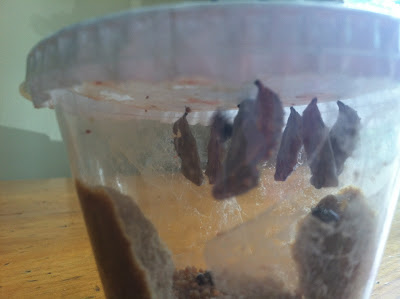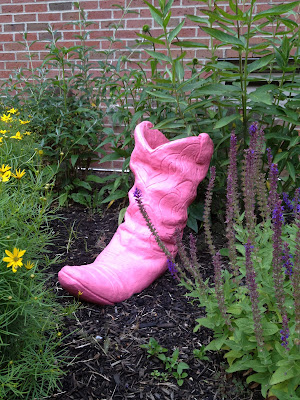Sunday, June 3, 2012
"A picture is a poem without words." - Horace
Madeira photographer, Don Sullivan visited the Butterfly Garden. Here's a collection of his beautiful work. Thanks for sharing your amazing talent with us!
Monday, May 28, 2012
Painted Lady . . . Metamorphosis
The Painted Lady caterpillars are
now in their chrysalises. We have 39
chrysalises (one caterpillar didn't make it).
It has been three days since the
caterpillars have formed their chrysalises so . . . it's moving time. I removed the lid and placed the filter on a
stack of paper towels in the bottom of a butterfly cage.
The butterflies don't need to be
hanging to successfully emerge - they can come out in the laying down
position. Twice a day the chrysalises need to be misted lightly
with water so they don't dry out. It
usually takes about 7 to 10 day for the butterfly to make its way out of the
chrysalises. It might look like nothing
is happening but it is really a time of rapid change. Within the chrysalis the old body parts of
the caterpillar are undergoing a remarkable transformation, called
metamorphosis.
The reddish liquid on the filter
paper is merconium. Merconium is excess
liquid the caterpillar didn't use during wing formation.
Friday, May 25, 2012
Thank you MES Fourth Graders!
The Madeira Elementary School fourth graders gave the butterfly garden a beautiful end of the school year gift.
The flower pot adds just the right amount of color to the garden.
All the students signed the pot with their names.
Tuesday, May 22, 2012
Caterpillars in the mail
A special package arrived in the mail with 40 Painted Lady caterpillar larvae. The caterpillar larvae came in two clear plastic cups with lids.
The sides of the cups had a thin coating of larvae food. Several of the caterpillar larvae were clinging to the sides of the cups while others were hanging from the lid.
I placed the cups in a warm place but not in direct sunlight. After a day the larvae were large (5/8") enough to transfer into their growing cups. I took the larvae food and pressed it to the sides of five clear plastic cups.
The "food" looked like cookie dough, felt like play dough and smelled like oatmeal.
I used the end of a paintbrush to move the larvae to their growing cup. Eight larvae per cup.
The larvae must stay in their growing cups until they form their chrysalis. Three days after the last caterpillar forms its chrysalis they need to be transferred to a wet paper towel placed in the bottom of a enclosed net. If the temperature stays near 85F the caterpillars should form into their chrysalis between 10 to 12 days.
Here's a picture of a Painted Lady.
The sides of the cups had a thin coating of larvae food. Several of the caterpillar larvae were clinging to the sides of the cups while others were hanging from the lid.
I placed the cups in a warm place but not in direct sunlight. After a day the larvae were large (5/8") enough to transfer into their growing cups. I took the larvae food and pressed it to the sides of five clear plastic cups.
The "food" looked like cookie dough, felt like play dough and smelled like oatmeal.
When the growing cups were ready, I took off the lid and the caterpillars started moving. They moved like inch worms.
The larvae must stay in their growing cups until they form their chrysalis. Three days after the last caterpillar forms its chrysalis they need to be transferred to a wet paper towel placed in the bottom of a enclosed net. If the temperature stays near 85F the caterpillars should form into their chrysalis between 10 to 12 days.
Here's a picture of a Painted Lady.
Monday, May 21, 2012
Spring has . . . Sprung!
"I love spring anywhere, but if I could choose I would always greet it in a garden." - Ruth Stout
There has been an explosion of color at the butterfly garden; from the bright yellow petite blossom of the coreopsis to the brilliant purple lavender. The garden has become the home of several croaking toads, busy bees and bright red cardinals.
The garden provides two different types of plants - those that provide nectar for butterflies (nectar source), and those that provide food (host plant) for their offspring the caterpillar.
Nectar source: yarrow, purple coneflower, coreopsis, lavender, pincushion, meadow sage, scabiosa, lilies, anise hyssop, butterfly weed.
Caterpillar host plants: milkweed, fennel, parsley, pentas and dill.
Coming soon: black eyed susan, butterfly bush, aster, daisies, phlox, bee balm, zinna, scarlet sage, salvia, and sunflowers.
Caterpillar host plants: milkweed, fennel, parsley, pentas and dill.
Coming soon: black eyed susan, butterfly bush, aster, daisies, phlox, bee balm, zinna, scarlet sage, salvia, and sunflowers.
Look closely and you can see one of our pollinators.
The Butterfly Garden and Daffodil Show
"The daffodil is our doorside queen; she pushes upward the sword already, to spot with sunshine the early green." W. Bryant
We've been working hard readying the butterfly garden for the Daffodil Show. The finishing touch . . . the pendant banner. The bright fabrics added to the pallet of color seen throughout the garden. A few weeks ago, our garden was a sea of yellow and white. Because of the unusually warm weather, daffodils bloomed two weeks early. Unfortunately, the Daffodil Show was near the end of blooming season.
The celebration started with the second grader's singing a few songs about nature. The music set the stage for a fun afternoon. Each class created a power point presentation, sharing their knowledge about worms, soil and daffodils.
Bill Lee from the Southwest Daffodil Society came. In the fall the Daffodil Society provided bags of bulbs for the second graders to plant in their home gardens.
The students brought in their "best" daffodil blossom. The flowers were displayed in individual containers.
It was amazing to see different daffodil species. There are over 200 different species and 25,000 hybrids.
Here is a Saint Keeper . . .
The students brought in their "best" daffodil blossom. The flowers were displayed in individual containers.
Here is a Saint Keeper . . .
Subscribe to:
Posts (Atom)




























































